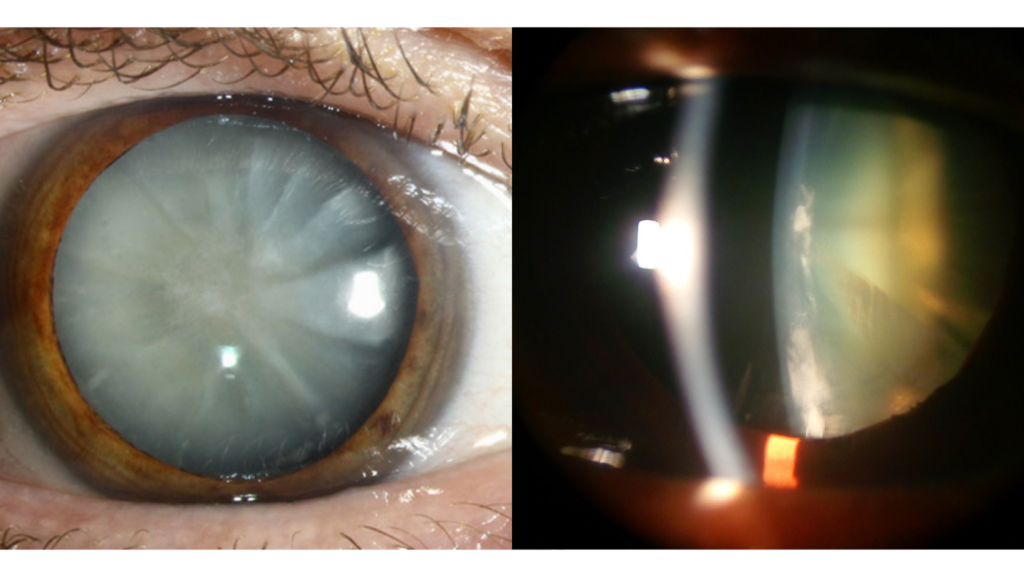Cataract Awareness Month!
June is for dads, grads, and… catarads? Ok. It’s “cataracts”. But pretend it’s pronounced like that because June is Cataract Awareness Month and that would be so. much. fun. In honor of Cataract Awareness Month, we’d like to take a moment to talk about what cataracts are, how they affect your vision, and what can be done about them.
What is A Cataract?
We’ve all heard the term before, but not everyone can state for sure exactly what and where a cataract is. Cataracts are a clouding of the lens, a clear structure behind your iris (the colored part of your eye).

The purpose of the lens is to focus the light onto your retina, where light is turned into an electrical impulse which is sent to your brain. As cataracts progress and the lens scatters light rather than precisely focusing it, we are left with blur, glare, and even color vision changes. You may have heard “cataract” in reference to waterfalls. This is where medicine has borrowed the term from, as it refers to that which was once clear, now being opacified.

Many of the images included in this post are taken from a doctor’s view in a slit lamp, the tabletop microscope in our exam rooms. Rarely in the US do we see cataracts with the naked eye. In the vast majority of cases cataracts are removed before they get to this hypermature state. This is perhaps the reason some folks are surprised to hear they have cataracts when it doesn’t quite look like the picture they’ve seen in National Geographic.

Getting Foggy
There are several types of cataract. But for our discussion today we will focus on the age related cataracts as they are the most common.
First, your lens is constantly making new layers of itself. This leads to a loss of transparency when the lens fibers compact and harden.
Second, the proteins that compose the lens have a very specific chemical structure that is responsible for their transparent nature. Over time these proteins, called crystillins, suffer changes to their chemical structure, resulting in a loss of transparency. Let’s talk a quick pause here and talk about *ONE* reason we here at The Eye Shop recommend sunglasses: UV light exacerbates these changes, leading to a loss of transparency sooner.
Finally, these proteins also exhibit a change in color, becoming more brown. This pigment change is called “brunescence”. If you’ve ever known someone who had cataract surgery and was stunned at the brightness of colors or didn’t realize the couch they bought was that shade of purple, this is why.
How Will I Know If I Have Cataracts?
The straight-forward answer to this question is this; we’ll tell you. Cataracts don’t cause any pain and in the early stages they don’t really affect your vision. Your doctor may first diagnose early-stage cataracts in your late 50’s or early 60’s. However, as your 60’s wear on you will notice more glare, halos, blurred vision, and difficulties completing tasks you used to do just fine with (night driving, reading the newspaper, playing golf with your friends, etc). Generally the cataracts are problematic enough to warrant a surgical consult in your early 70’s. But please remember, every case is different and this discussion on age-related cataracts cannot and should not replace your annual exam with us.

What Can You Tell Me About Cataract Surgery?
Let’s start with the basics. It’s an extremely common and highly successful procedure. About 3 million Americans get it every year and each eye only takes about 10 minutes to complete. This outpatient procedure requires no stitches and is not painful. The vast majority of patients have good vision by the next day, but be aware that complete healing can take 3-4 weeks.
The procedure involves the removal of your natural lens and the insertion of an implant lens. And can you imagine how cool it would be if they could put an implant lens that actually corrects your vision? Spoiler alert: that’s exactly what they do!

The lens implants range from basic on up to incredibly sophisticated. The basic lens will correct your vision for one focal plane; distance or near. Most patients that choose this option elect to have good distance vision and throw on readers from time to time when doing near work. If you’ve worn monovision contacts and are well-adapted to that mode of correction, that can also be done in cataract surgery!
Finally, a lot of the research and development in lens implant technology goes toward multifocal lenses. These lenses aim to give you distance AND near vision without the aid of glasses or contacts.
Does it feel overwhelming? That’s ok. Because part of this process is us connecting you with an amazing surgeon who will perform a complete evaluation, discuss what options may be best for you, and even have you sit with a counseling team at their office to discuss what is and isn’t covered by your insurance.
What About Recovery?
As mentioned before, this is an outpatient surgery. The procedure itself takes about 10-15 minutes, but you’re there for about 2 hours getting prepped and stabilized. They only do one eye at a time, and will follow up appointments/healing, you will want to make sure you have a solid month where you won’t be out of town or need to do any strenuous labor.
You will need a driver to take you to and from your surgical appointment because you will likely be a little loopy from the anesthetic. You will return to see the surgeon the next morning so they can evaluate your healing. Remember to have your driver available for this visit, too. As long as things are healing nicely, you will be cleared to drive and will return in one week for either the fellow eye or a one week follow up. Finally, after a 1 month follow up, the process is complete. Just remember to still see your eye doctor every year to monitor eye health.
Limitations During Recovery
Your surgeon and surgical counselor will give you a full list of things to avoid, as well as detailed instruction on when and how to take your post operative medications (eye drops). Generally, any eye rubbing must be avoided for a full month. Anything that causes strain should also be avoided for this time. Some are obvious (lifting heavy boxes, engaging in contact sports) while others are less so (leaning over past your waist for things as simple as lifting the cat bowl). You should avoid water getting into contact with your eyes, including the shower. Hot tubs and swimming pools should absolutely be avoided. As should eye makeup or anything else that could irritate the eyes. But again, your surgeon and their facility will discuss their specific limitations with you.
What questions do you have about cataracts?
Leave a Reply Cancel reply
follow us
schedule an appointment
website designed by katie & Co. Design
come visit us AT EITHER LOCATION!
The Eye Shop OCOTILLO
21321 E. Ocotillo #105,
Queen Creek, AZ 85142
THE EYE SHOP POWER
18550 E. RITTENHOUSE #100,
Queen Creek, AZ 85142